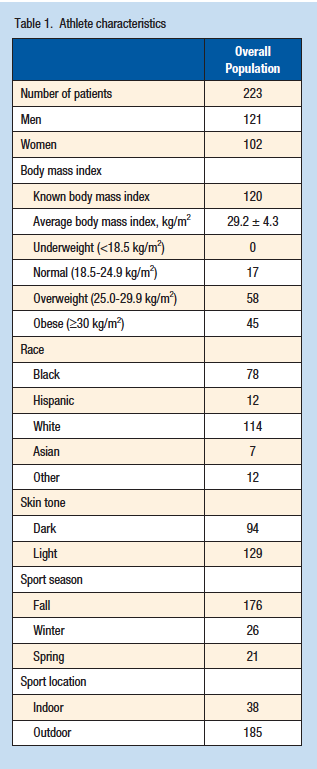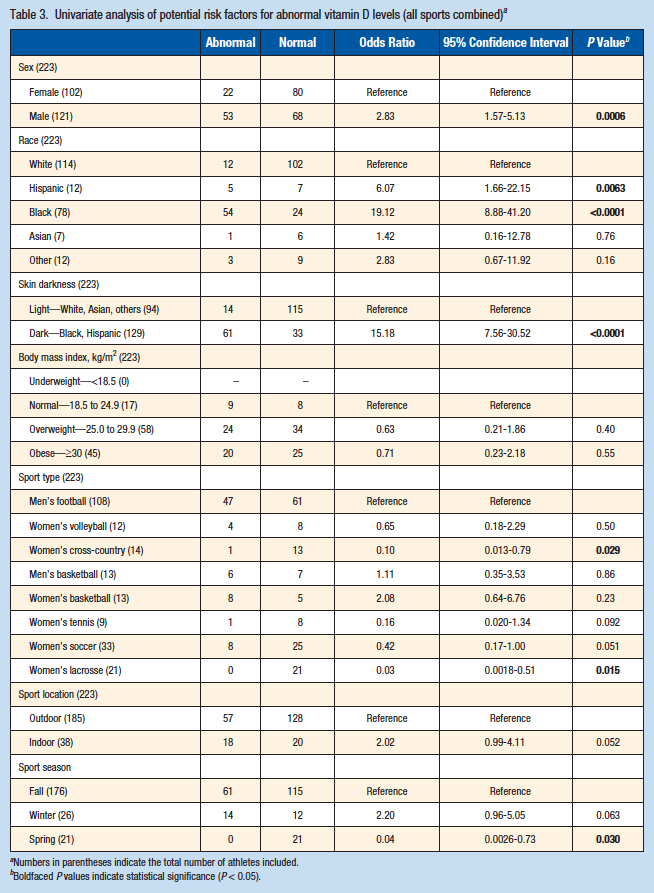NCAA athletes – one third had low levels of vitamin D, 19X more likely if black race
Prevalence of Abnormal Vitamin D Levels Among Division I NCAA Athletes
Presented at 2015 Annual Meeting of the American Academy of Orthopaedic Surgeons
Diego C. Villacis, MD, Los Angeles, California
Anthony Yi, BS, Los Angeles, California
Ryan Jahn, BS, Pasadena, California
Curtis J. Kephart, MD, Delray Beach, Florida
Timothy Charlton, MD, Los Angeles, California
Seth C. Gamradt, MD, Los Angeles, California
Russ Romano, MA, ATC, Los Angeles, California
James E. Tibone, MD, Los Angeles, California
George F. Hatch III, MD, Los Angeles, California
BACKGROUND: Up to 1 billion people have insufficient or deficient vitamin D levels. Despite the well-documented, widespread prevalence of low vitamin D levels and the importance of vitamin D for athletes, there is a paucity of research investigating the prevalence of vitamin D deficiency in athletes. Hypothesis: We investigated the prevalence of abnormal vitamin D levels in National Collegiate Athletic Association (NCAA) Division I college athletes at a single institution. We hypothesized that vitamin D insufficiency is prevalent among our cohort.
METHODS: We measured serum 25-hydroxyvitamin D (25(OH)D) levels of 223 NCAA Division I athletes between June 2012 and August 2012. The prevalence of normal (≥32 ng/mL), insufficient (20 to <32 ng/mL), and deficient (<20 ng/mL) vitamin D levels was determined. Logistic regression was utilized to analyze risk factors for abnormal vitamin D levels.
RESULTS: The mean serum 25(OH)D level for the 223 members of this study was 40.1 ± 14.9 ng/mL. Overall, 148 (66.4%) participants had sufficient 25(OH)D levels, and 75 (33.6%) had abnormal levels. Univariate analysis revealed the following significant predictors of abnormal vitamin D levels:
male sex (odds ratio [OR] = 2.83; P = 0.0006),
Hispanic race (OR = 6.07; P = 0.0063),
black race (OR = 19.1; P < 0.0001), and
dark skin tone (OR = 15.2; P < 0.0001).
Only dark skin tone remained a significant predictor of abnormal vitamin D levels after multivariate analysis (adjusted OR = 15.2; P < 0.0001).
CONCLUSION: In a large cohort of NCAA athletes, more than one third had abnormal vitamin D levels. Races with dark skin tones are at much higher risk than white athletes. Male athletes are more likely than female athletes to be vitamin D deficient. Our study demonstrates a high prevalence of vitamin D deficiency among healthy NCAA athletes. Clinical Relevance: Many studies indicate a significant prevalence of vitamin D insufficiency across various populations. Recent studies have demonstrated a direct relationship between serum 25(OH)D levels and muscle power, force, velocity, and optimal bone mass. In fact, studies examining muscle biopsies from patients with low vitamin D levels have demonstrated atrophic changes in type II muscle fibers, which are crucial to most athletes. Furthermore, insufficient 25(OH) D levels can result in secondary hyperparathyroidism, increased bone turnover, bone loss, and increased risk of low trauma fractures and muscle injuries. Despite this well-documented relationship between vitamin D and athletic performance, the prevalence of vitamin D deficiency in NCAA athletes has not been well studied.


See also VitaminDWiki
NCAA trainers are getting on board the Vitamin D train (40-50 ng)– Nov 2019
Only 1 NCAA basketball player getting 10,000 IU vitamin D daily achieved 50 ng goal – Jan 2020
Athletes (national-level) with less than 10 ng of vitamin D had smaller hearts – Jan 2014
NFL team less likely to cut players with high levels of vitamin D – Feb 2015
Many athletes now advised to take daily vitamin D supplements – Aug 2014
Dark skinned NCAA basketball players were 15X more likely to have low vitamin D – Feb 2014
- Same authors and study as the abstract on this page
Sports benefits from up to 50 ng of Vitamin – meta-analysis - Nov 2012
Overview Sports and vitamin D has the following summary
{include}
Pages which are listed in BOTH of the categories Dark Skin and Sports
{category}
